Scientific Name
Orbea lutea subsp. vaga (N.E.Br.) Bruyns
Synonym(s)
Caralluma vaga, Ceropegia lutea subsp. vaga, Orbeopsis lutea subsp. vaga, Orbeopsis vaga, Stapelia vaga
Scientific Classification
Family: Apocynaceae
Subfamily: Asclepiadoideae
Tribe: Ceropegieae
Subtribe: Stapeliinae
Genus: Orbea
Etymology
The subspecific epithet "vaga" (pronounced "VA-ga") means "wandering, rambling, strolling" and probably refers to the more diffuse populations of this variety.
Origin
The native range of Orbea lutea subsp. vaga extends more or less along the entire length of Namibia, expands into a small area of southwestern Angola, and continues southwards into South Africa. It grows in various habitats, from firm white sands to rocky flats and slopes under small bushes.
Description
Orbea lutea subsp. vaga is a highly branched succulent with grey-green stems, typically marked by bright mottling with red-brown tones. It can spread up to 3.3 feet (1 m) in diameter, forming small clumps or mats over time. The stems are 4-angled, erect to decumbent, measuring up to 4.8 inches (12 cm) in length and 1 inch (2.5 cm) in thickness, excluding teeth.
The striking flowers vary from blackish-maroon to reddish-brown, finely and very irregularly flecked with yellow. They appear in dense clusters, opening more or less simultaneously in summer. The fruits are paired, spindle-shaped follicles with brown, tightly packed seeds, each with a tuft of long, white hairs. They can grow up to 3.6 inches (9 cm) long.

How to Grow and Care for Orbea lutea subsp. vaga
Hardiness: USDA hardiness zones 9b to 10b: from 25°F (-3.9°C) to 40°F (4.4°C).
Several species are fairly easy to grow. Others, often those with slightly hairy stems and the more unusual flowers, are more challenging and require careful watering (with some fertilizer) during the growing season and complete water withdrawal during the winter months. A minimum winter temperature of 50°F (10°C) is acceptable, provided plants are kept dry. A heated growing bench or incubator can help delicate plants survive the colder months. However, many species live under shrubs in their habitat and prefer light shade rather than full sun.
A gritty compost is essential, and clay pots are advisable for the more delicate species. Some growers prefer a mineral-only compost to minimize the chance of a fungal attack on the roots. A layer of grit on the surface of the compost prevents moisture from accumulating around the base of the stems.
Keeping Stapelias and their roots free of pests, such as mealybugs, is the real key to success, as fungal attacks often occur due to damage to stems by insects.
See more at How to Grow and Care for Stapelia.
Links
- Back to genus Orbea
- Succupedia: Browse succulents by Scientific Name, Common Name, Genus, Family, USDA Hardiness Zone, Origin, or cacti by Genus
Photo Gallery
Click on a photo to see a larger version.


